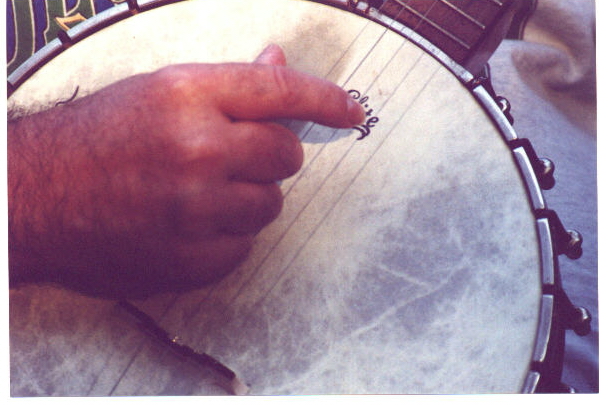Beginning Clawhammer Page...

Hi... to all you beginning
Clawhammer players!!!
It is my intent to list
all of the tools and gadgets that I used to get me started playing Clawhammer
banjo. This includes, books, videos, tapes, and such. Rhode Island isn't
exactly a hot bed for Clawhammer players, so I had to search far and wide
for infomation on this style of banjo playing. (I receive no compensation
for any artists works that I mention or any brand name that I use or speak
of. This listing is purely informational)
-
Banjo-Preferably open-back,
but any will do. If you can't find a 1926 Bacon, or a Vega Tubaphone, a
Deering, "Good Times" is an excellent beginners Clawhammer banjo. (Around
$300)
-
Music Stand-Unless you are
blessed with the ability to play by ear, then you will probably be learning
to play by tablature. A good solid music stand is essential to hold your
music, and other banjo related products that I will speak of. (Usually
Black, with a shelf, adjustable height, around $40-60)
-
Foot Stand- This is an adjustable
stand designed to raise your left foot 4-6 inches or so, to help you achieve
the desired angle at which your banjo is cocked. Mine is almost perpendicular
with my left shoulder.
-
Capo- This is a necessary
gizmo to allow a Clawhammer player to play in the many varied tunings
of this style. I have used many different types and have settled on the
Kyser. It is a one-handed type capo. You just squeeze the trigger and it
opens to allow application to any fret.($12-15) I have use the Shubbs,
which has a set screw and locks down on the fret. It works fine, but leaves
an indentation on my Bacon's fret board. (No matter what tension I set
it to) ($15-20) I use a cheap Dunlop for my "At work" banjo. It has a strip
of rubber mounted on a metal piece, that has 5 or 6 slots where you hook
in the strap and lock it down. Not fancy, but functional. ($3-5)
There are many types of capos; find the one that is right for you.
-
Strings- In my neighborhood,
Warwick, Rhode Island; there are not many choices for strings. If you are
there at the right time you can usually find some GHS, or D'Addario. For
anything else you have to do mail order. Thank God for the Internet. You
can shop around and find the strings that you want and get them cheap to
boot. I have tried the D'Aquisto's and the Labella's and the Vega's also
and have settled on the Vega lights for my Bacon, as well as the Franciscan
that I play at work. On my Bart Reiter I use Labella nylon strings, because
they were basically the only nylon I could find. Like all things banjo,
the strings are all a matter of what sounds good to your ear. This summer
at Winterhawk I played a Stelling banjo that had some of Geoff Stelling's
medium strings on it. I played it Clawhammer style of course and the banjo
sounded great! However, the strings were very rough and abrasive and within
15 minutes had worn a pretty deep groove in my nail. Not for frailin' I
would say...
-
Bridges- Like strings, there
are many types of bridges. I have tried the "Enterprise" bridge by Nechville
and found it to be kind of bright for the style that I play. I have also
used the Moon bridges, which I really like. I have tried the light and
medium 1/2" in the Moons and I like both. The medium seems to give the
tubbier sound that I am looking for. My only complaint about the Moon bridge
is that the ebonite seems to flake off and chip, especially on the 5th
string. Right now I am using a compensated on my Bacon, that I filed down
to almost nothing on the 3 legs. My action is low and this bridge needed
to come down in size. It sounds okay, so why mess with it. If you live
near a place that carries a lot of banjo bridges, go there and see if the
owner will allow you to try out some of the bridges. It seems that every
bridge is different, in the density of the wood, how much mositure it retains,
how old the wood is and other assorted factors. It is great if you have
the luxury of trying out different ones, to get the one that sounds good
to YOU.
-
Slow Banjo Necks- Sometimes
in the summer, when it is hot and sticky, the banjo neck gets very slow
and hard to slide up and down. We have a very high humidity level in Rhode
Island, many times above 80%. To help this problem I use a very soft rag
to wipe down the neck and string between songs. I also use a product called
"Fast-Fret" by GHS. You rub the stick over the neck of the banjo and the
strings and almost instantly, you are able to slide and glide just like
you used to... Works very well.. It claims not to damage the finish, but
on my Bacon, it looks to have caused a little discoloration. It could be
just wear and tear on the finish from being played for 70+ years. I still
use it...just so I can play in the summer.
-
-
Return to Home Page...
-
-
-



